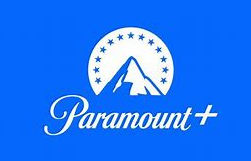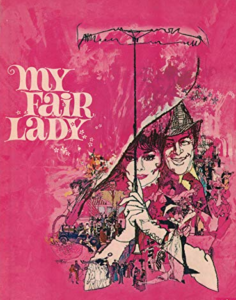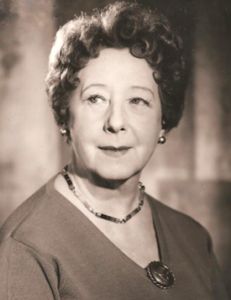This is a post about a pleasant surprise I had at the beginning of this year’s NFL play-off season. As we don’t have cable or dish TV, our viewing is limited to 13 over-the-air stations via a rooftop antenna and whatever our ROKU streaming device has to offer. My beloved Pittsburgh Steelers played the snowy Buffalo Bills on the CBS Network, but we couldn’t receive the local stations in Altoona nor Pittsburgh. So, for the first time, I paid $11.99 per month to watch the game on streaming Paramount + Premium. While the icy game was exciting, my iron men lost, leaving me with other play-offs and the Super Bowl to witness on the remaining days of my contract. I guess I’ll get over it. Meanwhile, my dear wife, who tolerates football, has had the opportunity to watch the countless programs offered by Paramount + and stumbled upon a musical from our high school days, “My Fair Lady.” I need to say also that we were both music majors in college, and have been saturated over the years with the wonderful creations of countless composers and musicians. While my wife directed high school choruses and orchestras accompanying Broadway shows from the pit before she retired, her contact with the music of “My Fair Lady” was limited to choral arrangements, solos in recitals, and recordings on old 33 1/33 LPs. So when she spotted the popular musical on Paramount +, she immediately made a date with her husband, me, to watch it. I offered no resistance.
Meanwhile, my dear wife, who tolerates football, has had the opportunity to watch the countless programs offered by Paramount + and stumbled upon a musical from our high school days, “My Fair Lady.” I need to say also that we were both music majors in college, and have been saturated over the years with the wonderful creations of countless composers and musicians. While my wife directed high school choruses and orchestras accompanying Broadway shows from the pit before she retired, her contact with the music of “My Fair Lady” was limited to choral arrangements, solos in recitals, and recordings on old 33 1/33 LPs. So when she spotted the popular musical on Paramount +, she immediately made a date with her husband, me, to watch it. I offered no resistance.
So, we hummed along with the overture and laughed at the pretty lady with the strong Cockney accent, Eliza Doolittle, as she sold her flowers in Central London. But, when the scene changed to Professor ‘Enry ‘Iggins ‘ouse, actually a mansion, our ears opened wider and our jaws dropped. The fair lady of the place was none other than a Mrs. Pearce. Notice the spelling’s the same as my last name. Neither I nor any of my extended family recalls being captured by her while watching the film and listening to the recording growing up. Of course we didn’t have a playbill nor stay for the credits at the end either. Now, we have closed captioning (CC) running all the time in all our British programs just to understand the unlike-American dialect so we easily spotted ‘Iggins addressing “Mrs. Pearce”. What follows, then is an accounting of many of the things we Pearces have in common.
Remember that I am an amateur family history researcher and writer with a website devoted to straight line genealogies and narratives of my wife and my ancestors. Lately, as the snows of winter in Appalachia have allowed me more time, I’ve managed to latch onto several namesakes and compose articles about them that you’ll find listed in the column to the right: British author A.J. Pearce, American actor Al Pearce, the Pearce’s of Lawana Blackwell’s novel “Leading Lady,” and even possible family ties to Diva Renee Fleming. Just the other day one TV network introduced us to a new Broadway musical with an unusual title: “How to Dance in Ohio”. It’s about a group of autistic teens trying to find their way in the social world despite their physical and mental disadvantages. I didn’t pay much attention until I was introduced to one of the stars, a Liam Pearce. We have a few things in common, as you’ll learn in an upcoming article.
But this piece is about Mrs. Pearce, the fictional housekeeper in Lerner and Loewe’s musical “My Fair Lady.” Her real name is Mona Washbourne (1903-1988). Although her role in that film was only supporting, she is best known for her award winning performance in the movie “Stevie.” She was 75-years old when it came out, yet she took home both Golden Globe and AFTA awards. But most successful by any standard, “My Fair Lady” was the second highest-grossing film of 1964, winning eight Academy Awards.
Born in Birmingham, UK, Washbourn trained as a concert pianist and began performing professionally in her late teens. A wonderful actress, she even gets to sing in the show in a piece aptly titled “Servants Chorus.” Music runs in the family as her sister was a violinist with the BBC Symphony Orchestra. She married an actor, and her brother-in-law, Mark Digham, was also well known on stage and in film. More information is available by Googling “Mona Washbourne.” Suffice it to say that she was equally at home in the Royal Court Theatre and on Broadway. This is a good time to name drop the personage of Jimmy Stewart, a native of Indiana, PA, the home of my alma mater [link]. They appeared together in 1975 in London.
One critic once lovingly called Mona a “bossomy old biddie” for her many effective portrayals of matrons. Another reviewer described her as “stern and caustic” in other roles. Of special interest to this retired American English language teacher was her ability to use various British accents in persuasively carrying out those roles.
The surname Washbourne carries several ironies. Although she served as the female head of the household in “My Fair Lady,” the word “wash” is certainly fitting for the duties of those beneath her. Secondly, for me personally, being familiar with my Pearce Family Narrative of origin, the town of Bourne, UK, was the hamlet where my Great-great grandfather Richard and his twin Sarah were born. They later married a sister and brother from Kent, the Austens, and set sail for America in 1820 from the London Docks. Despite probably investigating the wrong town back in 1996, Bourne, Lincolnshire, I later found that a River Bourne in Wiltshire ends in Salisbury, dumping into the famous Avon. The other River Bourne is just south in Dorset and leads to the port of Bournemouth. Given the generous nature of old oral narratives, it’s unclear today, over two centuries later, exactly my Pearce family’s time or point of departure. But one more saving irony remains to this American Pearce: the English word “bourne” actually means “departure,” a place from which a person leaves, whether it be by stream or ocean. And how could we forget the name of the London church where my great-great grandparents and their in-laws were married, “Marylebone,” the Queen’s Church? A famous London theater of the same name is pictured above.
If you’ll excuse my exuberance over the discover of Mona Washbourne as Mrs. Pearce, “Wouldn’t it be Loverly” for this “Ordinary Man” to have “A Little Bit of Luck” in finding more Pearces possibly related to to mine in some way, ethnicly, musically, linguistically, or any other way. “Just You Wait!”
Last revised 1/26/24




